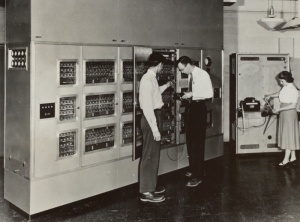Difference between revisions of "Artificial Intelligence in the Music Industry"
| Line 4: | Line 4: | ||
==History== | ==History== | ||
| + | |||
| + | The first recorded instance of computer-generated music was in 1951 by British mathematician, Alan Turing. Turing built the BBC outside-broadcast unit at the Computing Machine Library in Manchester, England, and used it to generate a variety of different melodies. To do so, he programmed the musical notes into the computer. Artificial intelligence was first used to create music in 1957 by Lejaren Hiller and Leonard Isaacson from the University of Illinois at Urbana–Champaign <ref> Li, Chong. “A Retrospective of AI + Music - Prototypr.” Medium, 25 Sept. 2019, blog.prototypr.io/a-retrospective-of-ai-music-95bfa9b38531. </ref>. They programmed the ILLIAC (Illinois Automatic Computer) to generate music completely written by artificial intelligence. Around this same time, Russian researcher R.Kh.Zaripov published the first paper on algorithmic music composing that was available worldwide. He used the historical Russian computer, URAL-1, to do so <ref> Li, Chong. “A Retrospective of AI + Music - Prototypr.” Medium, 25 Sept. 2019, blog.prototypr.io/a-retrospective-of-ai-music-95bfa9b38531. </ref> | ||
| + | <ref> Freeman, Jeremy. “Artificial Intelligence and Music — What the Future Holds?” Medium, 24 Feb. 2020, medium.com/@jeremy.freeman_53491/artificial-intelligence-and-music-what-the-future-holds-79005bba7e7d. </ref> . | ||
| + | |||
| + | |||
| + | From then on, research and software around AI generate music began to flourish. In 1974, the first International Computer Music Conference (ICMC) was hosted at Michigan State University in East Lansing, Michigan. This became an annual event hosted by the International Computer Music Association (ICMA) for AI composers and researchers alike <ref> Freeman, Jeremy. “Artificial Intelligence and Music — What the Future Holds?” Medium, 24 Feb. 2020, medium.com/@jeremy.freeman_53491/artificial-intelligence-and-music-what-the-future-holds-79005bba7e7d. </ref> . | ||
==Applications== | ==Applications== | ||
Revision as of 19:16, 13 March 2021
Artificial Intelligence in the Music Industry is a relatively new phenomenon that has already had a huge impact on the way we produce, consume, and experience music. Artificial intelligence (AI) itself is essentially a system created to learn and respond in a way that is similar to human beings. To some degree, AI technologies can simulate human intelligence and many different companies have developed applications that can create, perform, and/or curate music through the power of AI [1] . This growing industry is relatively new, but growing rapidly. This may cause future problems for artists who must compete against machines and legal discrepancies regarding copyrighted materials.
Contents
History
The first recorded instance of computer-generated music was in 1951 by British mathematician, Alan Turing. Turing built the BBC outside-broadcast unit at the Computing Machine Library in Manchester, England, and used it to generate a variety of different melodies. To do so, he programmed the musical notes into the computer. Artificial intelligence was first used to create music in 1957 by Lejaren Hiller and Leonard Isaacson from the University of Illinois at Urbana–Champaign [2]. They programmed the ILLIAC (Illinois Automatic Computer) to generate music completely written by artificial intelligence. Around this same time, Russian researcher R.Kh.Zaripov published the first paper on algorithmic music composing that was available worldwide. He used the historical Russian computer, URAL-1, to do so [3] [4] .
From then on, research and software around AI generate music began to flourish. In 1974, the first International Computer Music Conference (ICMC) was hosted at Michigan State University in East Lansing, Michigan. This became an annual event hosted by the International Computer Music Association (ICMA) for AI composers and researchers alike [5] .
Applications
Music Production
Recommendation Models
Collaborative Modeling
Natural Language Processing
Convolutional Neural Networks
Artists Utilizing AI
Ethical Implications
Commodification of Music
Big Data
Copyright
Objectification of Women
Synthesizing Voices of the Deceased
See Also
References
- ↑ Freeman, Jeremy. “Artificial Intelligence and Music — What the Future Holds?” Medium, 24 Feb. 2020, medium.com/@jeremy.freeman_53491/artificial-intelligence-and-music-what-the-future-holds-79005bba7e7d.
- ↑ Li, Chong. “A Retrospective of AI + Music - Prototypr.” Medium, 25 Sept. 2019, blog.prototypr.io/a-retrospective-of-ai-music-95bfa9b38531.
- ↑ Li, Chong. “A Retrospective of AI + Music - Prototypr.” Medium, 25 Sept. 2019, blog.prototypr.io/a-retrospective-of-ai-music-95bfa9b38531.
- ↑ Freeman, Jeremy. “Artificial Intelligence and Music — What the Future Holds?” Medium, 24 Feb. 2020, medium.com/@jeremy.freeman_53491/artificial-intelligence-and-music-what-the-future-holds-79005bba7e7d.
- ↑ Freeman, Jeremy. “Artificial Intelligence and Music — What the Future Holds?” Medium, 24 Feb. 2020, medium.com/@jeremy.freeman_53491/artificial-intelligence-and-music-what-the-future-holds-79005bba7e7d.
